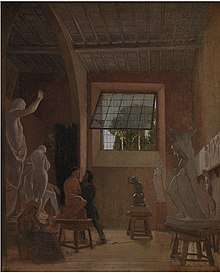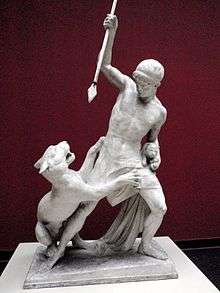Jens Adolf Jerichau
Emil Jens Baumann Adolf Jerichau (17 April 1816 – 25 July 1883) was a Danish sculptor. He belonged to the generation immediately after Bertel Thorvaldsen, for whom he worked briefly in Rome, but gradually moved away from the static Neoclassicism he inherited from him and towards a more dynamic and realistic style.He was a professor at the Royal Danish Academy of Fine Arts and its director from 1857 to 1863.
Jens Adolf Jerichau | |
|---|---|
 Jens Adolf Jerichau by his wife Elisabeth Jerichau-Baumann | |
| Born | 17 April 1816 Assens, Denmark |
| Died | 25 July 1883 (aged 67) Copenhagen, Denmark |
| Nationality | Danish |
| Education | Royal Danish Academy of Fine Arts |
| Known for | Sculptor |
| Movement | Neoclassicism (early works) Naturalism (later works) |
Early life and career

Jens Adolf Jerichau was born on 17 April 1816 in Assens on the Danish island of Funen to grocer and lieutenant Carl Christian Jerichau and his wife Karen Birch. He worked in a painter's apprenticeship for one and a half years before traveling to Copenhagen where he was admitted to the Royal Academy of Fine Arts in 1831. He was accepted into the model school in 1833 and continued to the painting school, at the same time studying privately with Christoffer Wilhelm Eckersberg, after winning both silver medals. Then in 1836 he started sculpting with Hermann Ernst Freund
Years in Rome

After graduating from the Academy in 1837, Jerichau traveled to Rome where he initially worked for around a year in Bertel Thorvaldsen's studio. He established his calling through a bas-relief on a frieze in the royal palace Christiansborg in Copenhagen, depicting the marriage of Alexander the Great to Roxane.
His early works such as the sculpture Hercules and Hebe (1846, original model in the Ny Carlsberg Glyptotek)as well as his colossal Christ figure from 1849 are in a strong Neoclassical style which bear clear testament to Thorvaldsen.
Finding his own style

With his sculpture group Penelope (1845–46, Danish National Gallery), which won international acclaim, he moved away from the static Neoclassicism and towards a more dramatic and dynamic style. He created also formed depictions of nature, such as The Panther Hunter.
As a result of a commission from the Princess of Prussia, he produced a depiction of the resurrection of Christ. He died on 25 July 1883.
A number of his most famous works were damaged or ruined in a fire in the Christiansborg Palace in 1884.[1]
Family
Jerichau married the painter Elisabeth Jerichau-Baumann and they had 9 children, including painter Harald Jerichau.
Selected works
- Adam and Eve before the Fall, Danish National Gallery, Copenhagen (1863)
- Standing Goat, Danish National Gallery, Copenhagen
- Bathing Women, Danish National Gallery, Copenhagen
- Sleeping Reaper,
- Little girl with a dead bird
- The Panther Hunter (1846)
- Slave Giirl, Danish National Gallery, Copenhagen
Public art
- H. C. Ørsted Memorial, Copenhagen (1871)
- Crucifix, Jesus Church, Valby, Copenhagen
- David, Church of Our Lady, Copenahgen
Bibliography
- Nicolaj Bøgh, Erindringer af og om Jens Adolf Jerichau (1884).
References
- New York Times (July 26, 1883) "Obituary"
External links
- Jens Adolf Jerichau at Kunstindeks Danmark
| Cultural offices | ||
|---|---|---|
| Preceded by Wilhelm Marstrand |
Director of the Royal Danish Academy of Fine Arts 1857–1863 |
Succeeded by Wilhelm Marstrand |